sensor CADILLAC ESCALADE EXT 2007 3.G User Guide
[x] Cancel search | Manufacturer: CADILLAC, Model Year: 2007, Model line: ESCALADE EXT, Model: CADILLAC ESCALADE EXT 2007 3.GPages: 580, PDF Size: 3.01 MB
Page 213 of 580

Ultrasonic Rear Parking
Assist (URPA)
If your vehicle has the Ultrasonic Rear Parking
Assist (URPA) system it is designed to help
you park while in REVERSE (R). It operates only
at speeds less than 5 mph (8 km/h). URPA
helps make parking easier and helps you avoid
colliding with objects such as parked vehicles. The
URPA system detects objects that are close to
the rear of the vehicle which are at least 10 inches
(25.4 cm) off the ground and below hood or
tailgate level. The system detects objects up to
8 feet (2.5 m) behind your vehicle. The URPA
sensors determine how close these objects are
from your bumper within this area.
{CAUTION:
Even with the Ultrasonic Rear Park Assist
system, the driver must check carefully
before backing up. The system does not
CAUTION: (Continued)
CAUTION: (Continued)
operate above speeds of 5 mph
(8 km/h). The system does not detect
objects more than 8 feet (2.5 meters)
behind the vehicle. This detection
distance limit may be reduced during
warm weather or high humidity. Also, the
system does not detect objects that are
below your bumper, underneath your
vehicle, or some objects very close to the
vehicle. The system is not designed to
detect children, pedestrians, bicyclists,
or pets.
So, unless you check carefully behind
your vehicle while you are backing up,
they could be injured or killed.
Whether or not you are using rear park
assist, always check carefully behind your
vehicle before backing up and then watch
closely as you do.
213
Page 216 of 580
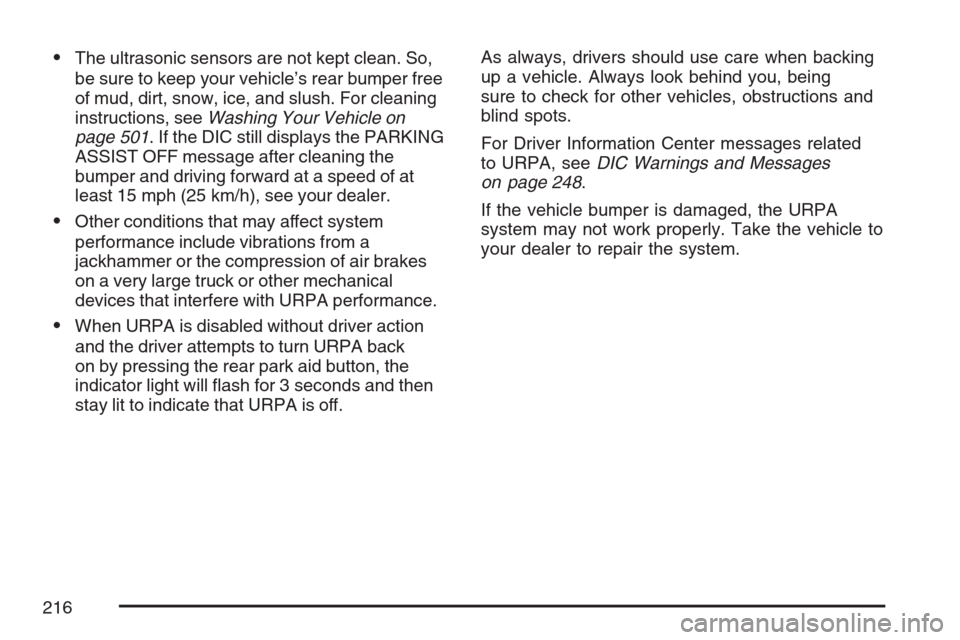
The ultrasonic sensors are not kept clean. So,
be sure to keep your vehicle’s rear bumper free
of mud, dirt, snow, ice, and slush. For cleaning
instructions, seeWashing Your Vehicle on
page 501. If the DIC still displays the PARKING
ASSIST OFF message after cleaning the
bumper and driving forward at a speed of at
least 15 mph (25 km/h), see your dealer.
Other conditions that may affect system
performance include vibrations from a
jackhammer or the compression of air brakes
on a very large truck or other mechanical
devices that interfere with URPA performance.
When URPA is disabled without driver action
and the driver attempts to turn URPA back
on by pressing the rear park aid button, the
indicator light will �ash for 3 seconds and then
stay lit to indicate that URPA is off.As always, drivers should use care when backing
up a vehicle. Always look behind you, being
sure to check for other vehicles, obstructions and
blind spots.
For Driver Information Center messages related
to URPA, seeDIC Warnings and Messages
on page 248.
If the vehicle bumper is damaged, the URPA
system may not work properly. Take the vehicle to
your dealer to repair the system.
216
Page 221 of 580

Be careful not to cover the sensor located on the
top of the instrument panel near the windshield.
This sensor regulates air temperature based
on sun load and also turns on your headlamps.
To avoid blowing cold air in cold weather, the
system will delay turning on the fan until warm air
is available. The length of delay depends on
the engine coolant temperature. Pressing the fan
switch will override this delay and change the
fan to a selected speed.
O(Off):Press the driver’s side temperature
knob to turn off the climate control system.
Outside air will still enter the vehicle, and will
be directed to the �oor. This direction can
be changed by pressing the mode button. The
temperature can also be adjusted using either
temperature knob. Press the up or down arrows
on the fan switch, the defrost button, the
AUTO button, driver’s side temperature knob,
or the air conditioning button to turn the system on
when it is off.
Manual Operation
You may manually adjust the air delivery mode or
fan speed.
y9 z(Fan):The switch with the fan symbol
allows you to manually adjust the fan speed.
Press the up arrow to increase fan speed and the
down arrow to decrease fan speed.
Pressing this button when the system is off will
turn the system on.
Pressing either arrow while using automatic
operation will place the fan in manual operation.
The fan setting will display and the AUTO light will
turn off. The air delivery will remain in automatic
operation.
N(Mode):Press this button to manually change
the direction of the air�ow in your vehicle.
Repeatedly press the button until the desired
mode appears on the display.
When the system is turned off, the display will go
blank after displaying the current status of the
system.
221
Page 229 of 580

Airbag Readiness Light
There is an airbag readiness light on the
instrument panel, which shows the airbag symbol.
The system checks the airbag’s electrical system
for malfunctions. The light tells you if there is an
electrical problem. The system check includes the
airbag sensors, the airbag modules, the wiring and
the crash sensing and diagnostic module. For more
information on the airbag system, seeAirbag
System on page 67.
This light will come on
when you start your
vehicle, and it will �ash
for a few seconds. Then
the light should go out.
This means the system
is ready.{CAUTION:
If the airbag readiness light stays on after
you start your vehicle, it means the airbag
system may not be working properly. The
airbags in your vehicle may not in�ate in
a crash, or they could even in�ate without
a crash. To help avoid injury to yourself
or others, have your vehicle serviced right
away if the airbag readiness light stays on
after you start your vehicle.
If the airbag readiness light stays on after you
start the vehicle or comes on when you are
driving, your airbag system may not work
properly. Have your vehicle serviced right away.
The airbag readiness light should �ash for a
few seconds when you turn the ignition key to
RUN. If the light does not come on then, have
it �xed so it will be ready to warn you if there is
a problem.
229
Page 247 of 580
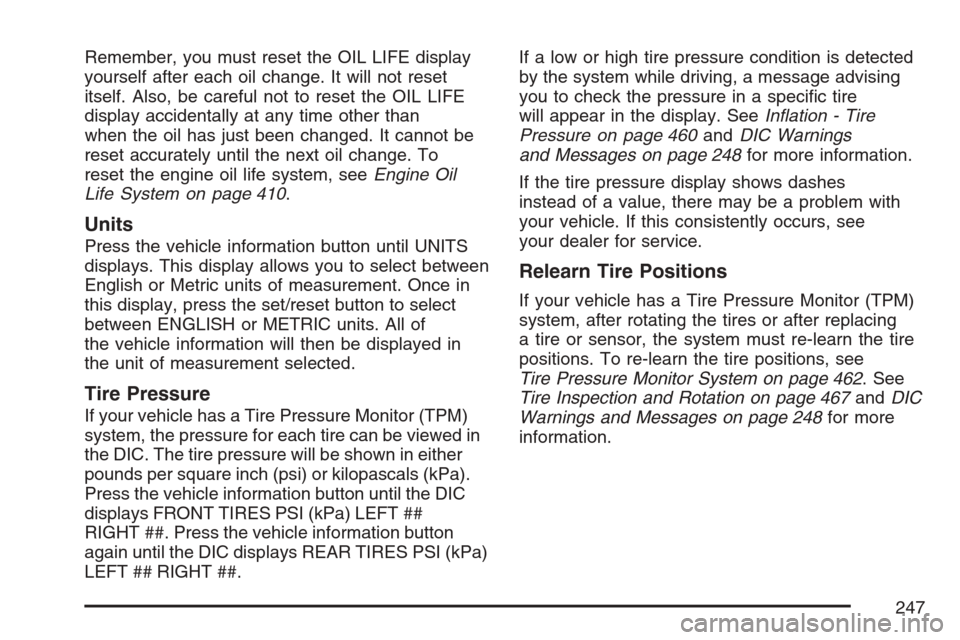
Remember, you must reset the OIL LIFE display
yourself after each oil change. It will not reset
itself. Also, be careful not to reset the OIL LIFE
display accidentally at any time other than
when the oil has just been changed. It cannot be
reset accurately until the next oil change. To
reset the engine oil life system, seeEngine Oil
Life System on page 410.
Units
Press the vehicle information button until UNITS
displays. This display allows you to select between
English or Metric units of measurement. Once in
this display, press the set/reset button to select
between ENGLISH or METRIC units. All of
the vehicle information will then be displayed in
the unit of measurement selected.
Tire Pressure
If your vehicle has a Tire Pressure Monitor (TPM)
system, the pressure for each tire can be viewed in
the DIC. The tire pressure will be shown in either
pounds per square inch (psi) or kilopascals (kPa).
Press the vehicle information button until the DIC
displays FRONT TIRES PSI (kPa) LEFT ##
RIGHT ##. Press the vehicle information button
again until the DIC displays REAR TIRES PSI (kPa)
LEFT ## RIGHT ##.If a low or high tire pressure condition is detected
by the system while driving, a message advising
you to check the pressure in a speci�c tire
will appear in the display. SeeIn�ation - Tire
Pressure on page 460andDIC Warnings
and Messages on page 248for more information.
If the tire pressure display shows dashes
instead of a value, there may be a problem with
your vehicle. If this consistently occurs, see
your dealer for service.
Relearn Tire Positions
If your vehicle has a Tire Pressure Monitor (TPM)
system, after rotating the tires or after replacing
a tire or sensor, the system must re-learn the tire
positions. To re-learn the tire positions, see
Tire Pressure Monitor System on page 462. See
Tire Inspection and Rotation on page 467andDIC
Warnings and Messages on page 248for more
information.
247
Page 250 of 580
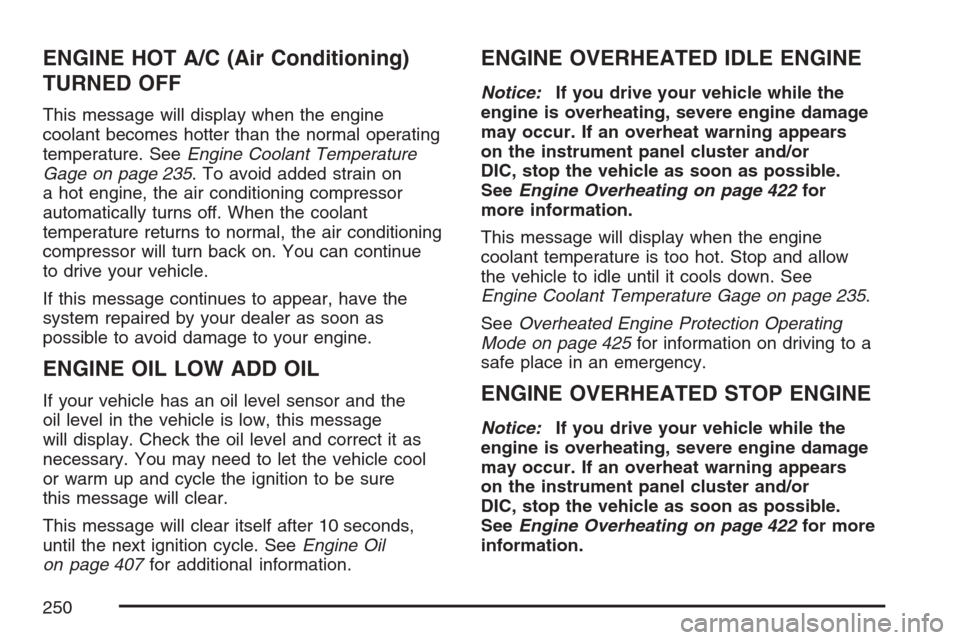
ENGINE HOT A/C (Air Conditioning)
TURNED OFF
This message will display when the engine
coolant becomes hotter than the normal operating
temperature. SeeEngine Coolant Temperature
Gage on page 235. To avoid added strain on
a hot engine, the air conditioning compressor
automatically turns off. When the coolant
temperature returns to normal, the air conditioning
compressor will turn back on. You can continue
to drive your vehicle.
If this message continues to appear, have the
system repaired by your dealer as soon as
possible to avoid damage to your engine.
ENGINE OIL LOW ADD OIL
If your vehicle has an oil level sensor and the
oil level in the vehicle is low, this message
will display. Check the oil level and correct it as
necessary. You may need to let the vehicle cool
or warm up and cycle the ignition to be sure
this message will clear.
This message will clear itself after 10 seconds,
until the next ignition cycle. SeeEngine Oil
on page 407for additional information.
ENGINE OVERHEATED IDLE ENGINE
Notice:If you drive your vehicle while the
engine is overheating, severe engine damage
may occur. If an overheat warning appears
on the instrument panel cluster and/or
DIC, stop the vehicle as soon as possible.
SeeEngine Overheating on page 422for
more information.
This message will display when the engine
coolant temperature is too hot. Stop and allow
the vehicle to idle until it cools down. See
Engine Coolant Temperature Gage on page 235.
SeeOverheated Engine Protection Operating
Mode on page 425for information on driving to a
safe place in an emergency.
ENGINE OVERHEATED STOP ENGINE
Notice:If you drive your vehicle while the
engine is overheating, severe engine damage
may occur. If an overheat warning appears
on the instrument panel cluster and/or
DIC, stop the vehicle as soon as possible.
SeeEngine Overheating on page 422for more
information.
250
Page 255 of 580
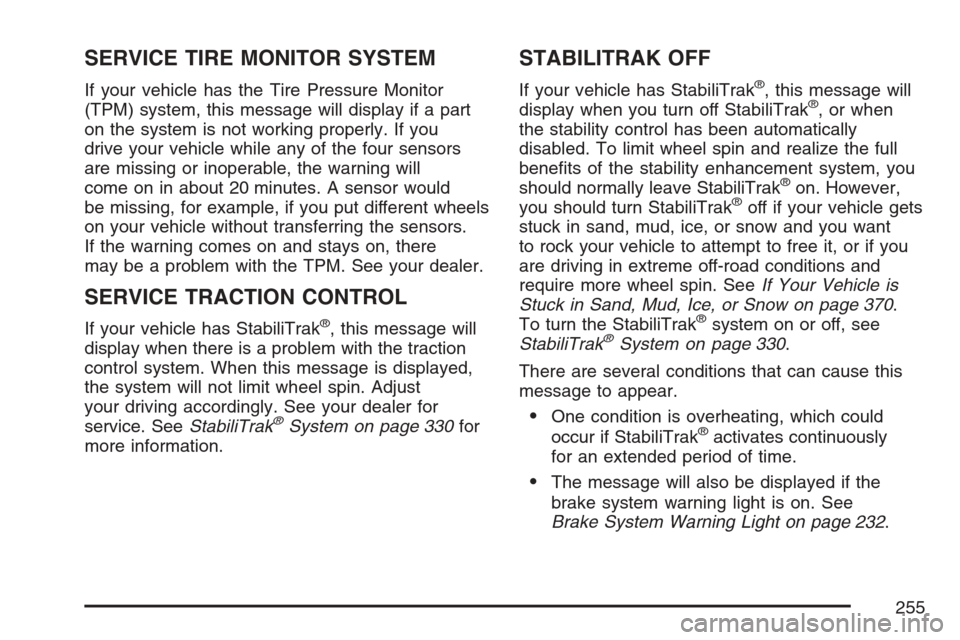
SERVICE TIRE MONITOR SYSTEM
If your vehicle has the Tire Pressure Monitor
(TPM) system, this message will display if a part
on the system is not working properly. If you
drive your vehicle while any of the four sensors
are missing or inoperable, the warning will
come on in about 20 minutes. A sensor would
be missing, for example, if you put different wheels
on your vehicle without transferring the sensors.
If the warning comes on and stays on, there
may be a problem with the TPM. See your dealer.
SERVICE TRACTION CONTROL
If your vehicle has StabiliTrak®, this message will
display when there is a problem with the traction
control system. When this message is displayed,
the system will not limit wheel spin. Adjust
your driving accordingly. See your dealer for
service. SeeStabiliTrak
®System on page 330for
more information.
STABILITRAK OFF
If your vehicle has StabiliTrak®, this message will
display when you turn off StabiliTrak®, or when
the stability control has been automatically
disabled. To limit wheel spin and realize the full
bene�ts of the stability enhancement system, you
should normally leave StabiliTrak
®on. However,
you should turn StabiliTrak®off if your vehicle gets
stuck in sand, mud, ice, or snow and you want
to rock your vehicle to attempt to free it, or if you
are driving in extreme off-road conditions and
require more wheel spin. SeeIf Your Vehicle is
Stuck in Sand, Mud, Ice, or Snow on page 370.
To turn the StabiliTrak
®system on or off, see
StabiliTrak®System on page 330.
There are several conditions that can cause this
message to appear.
One condition is overheating, which could
occur if StabiliTrak®activates continuously
for an extended period of time.
The message will also be displayed if the
brake system warning light is on. See
Brake System Warning Light on page 232.
255
Page 256 of 580
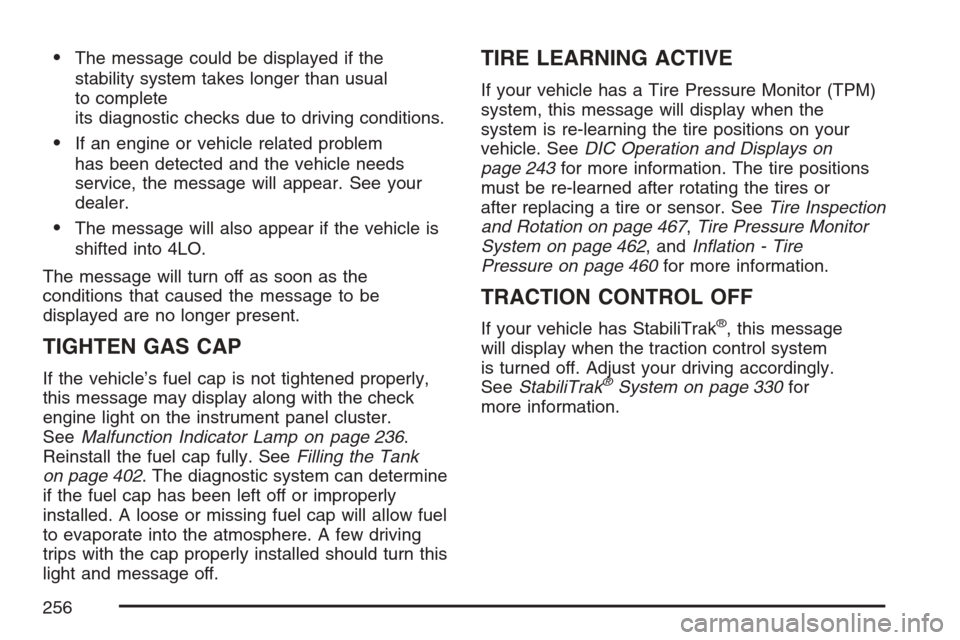
The message could be displayed if the
stability system takes longer than usual
to complete
its diagnostic checks due to driving conditions.
If an engine or vehicle related problem
has been detected and the vehicle needs
service, the message will appear. See your
dealer.
The message will also appear if the vehicle is
shifted into 4LO.
The message will turn off as soon as the
conditions that caused the message to be
displayed are no longer present.
TIGHTEN GAS CAP
If the vehicle’s fuel cap is not tightened properly,
this message may display along with the check
engine light on the instrument panel cluster.
SeeMalfunction Indicator Lamp on page 236.
Reinstall the fuel cap fully. SeeFilling the Tank
on page 402. The diagnostic system can determine
if the fuel cap has been left off or improperly
installed. A loose or missing fuel cap will allow fuel
to evaporate into the atmosphere. A few driving
trips with the cap properly installed should turn this
light and message off.
TIRE LEARNING ACTIVE
If your vehicle has a Tire Pressure Monitor (TPM)
system, this message will display when the
system is re-learning the tire positions on your
vehicle. SeeDIC Operation and Displays on
page 243for more information. The tire positions
must be re-learned after rotating the tires or
after replacing a tire or sensor. SeeTire Inspection
and Rotation on page 467,Tire Pressure Monitor
System on page 462, andIn�ation - Tire
Pressure on page 460for more information.
TRACTION CONTROL OFF
If your vehicle has StabiliTrak®, this message
will display when the traction control system
is turned off. Adjust your driving accordingly.
SeeStabiliTrak
®System on page 330for
more information.
256
Page 462 of 580
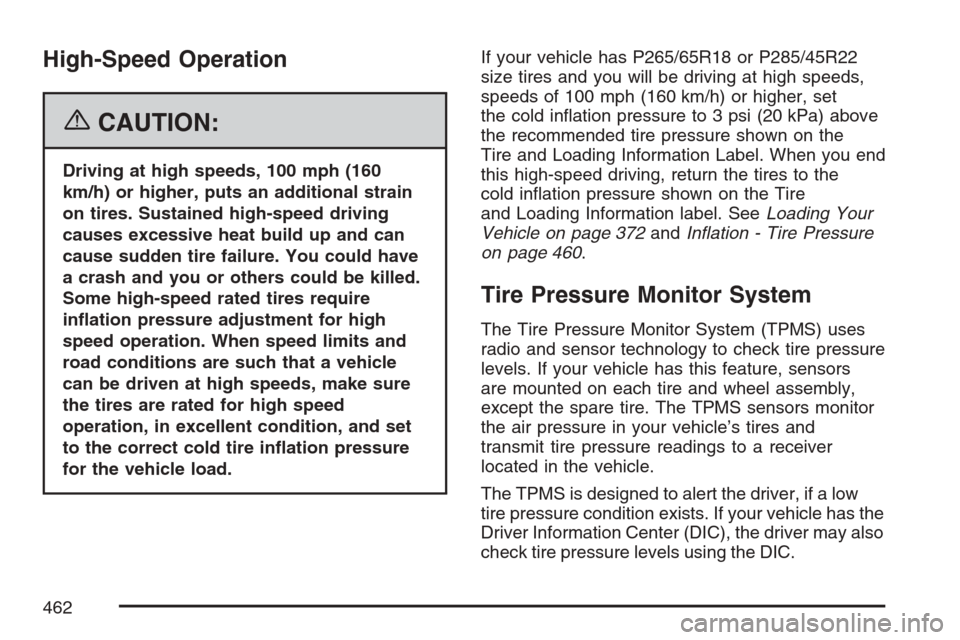
High-Speed Operation
{CAUTION:
Driving at high speeds, 100 mph (160
km/h) or higher, puts an additional strain
on tires. Sustained high-speed driving
causes excessive heat build up and can
cause sudden tire failure. You could have
a crash and you or others could be killed.
Some high-speed rated tires require
in�ation pressure adjustment for high
speed operation. When speed limits and
road conditions are such that a vehicle
can be driven at high speeds, make sure
the tires are rated for high speed
operation, in excellent condition, and set
to the correct cold tire in�ation pressure
for the vehicle load.If your vehicle has P265/65R18 or P285/45R22
size tires and you will be driving at high speeds,
speeds of 100 mph (160 km/h) or higher, set
the cold in�ation pressure to 3 psi (20 kPa) above
the recommended tire pressure shown on the
Tire and Loading Information Label. When you end
this high-speed driving, return the tires to the
cold in�ation pressure shown on the Tire
and Loading Information label. SeeLoading Your
Vehicle on page 372andIn�ation - Tire Pressure
on page 460.
Tire Pressure Monitor System
The Tire Pressure Monitor System (TPMS) uses
radio and sensor technology to check tire pressure
levels. If your vehicle has this feature, sensors
are mounted on each tire and wheel assembly,
except the spare tire. The TPMS sensors monitor
the air pressure in your vehicle’s tires and
transmit tire pressure readings to a receiver
located in the vehicle.
The TPMS is designed to alert the driver, if a low
tire pressure condition exists. If your vehicle has the
Driver Information Center (DIC), the driver may also
check tire pressure levels using the DIC.
462
Page 465 of 580
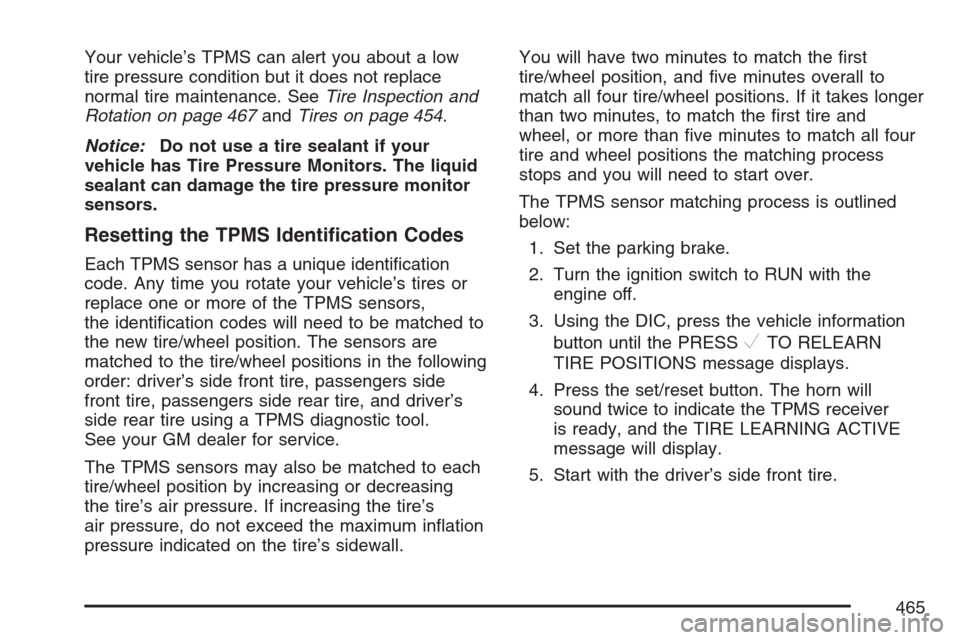
Your vehicle’s TPMS can alert you about a low
tire pressure condition but it does not replace
normal tire maintenance. SeeTire Inspection and
Rotation on page 467andTires on page 454.
Notice:Do not use a tire sealant if your
vehicle has Tire Pressure Monitors. The liquid
sealant can damage the tire pressure monitor
sensors.
Resetting the TPMS Identi�cation Codes
Each TPMS sensor has a unique identi�cation
code. Any time you rotate your vehicle’s tires or
replace one or more of the TPMS sensors,
the identi�cation codes will need to be matched to
the new tire/wheel position. The sensors are
matched to the tire/wheel positions in the following
order: driver’s side front tire, passengers side
front tire, passengers side rear tire, and driver’s
side rear tire using a TPMS diagnostic tool.
See your GM dealer for service.
The TPMS sensors may also be matched to each
tire/wheel position by increasing or decreasing
the tire’s air pressure. If increasing the tire’s
air pressure, do not exceed the maximum in�ation
pressure indicated on the tire’s sidewall.You will have two minutes to match the �rst
tire/wheel position, and �ve minutes overall to
match all four tire/wheel positions. If it takes longer
than two minutes, to match the �rst tire and
wheel, or more than �ve minutes to match all four
tire and wheel positions the matching process
stops and you will need to start over.
The TPMS sensor matching process is outlined
below:
1. Set the parking brake.
2. Turn the ignition switch to RUN with the
engine off.
3. Using the DIC, press the vehicle information
button until the PRESS
VTO RELEARN
TIRE POSITIONS message displays.
4. Press the set/reset button. The horn will
sound twice to indicate the TPMS receiver
is ready, and the TIRE LEARNING ACTIVE
message will display.
5. Start with the driver’s side front tire.
465